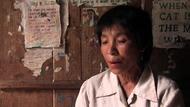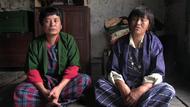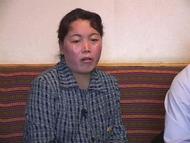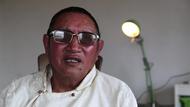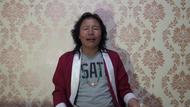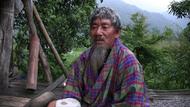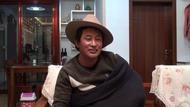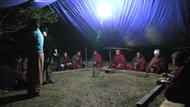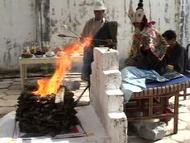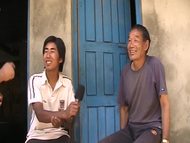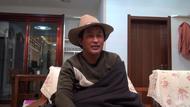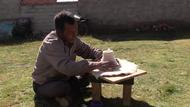Video Overview
A doctor comments on some aspects of factory operations at the Tibetan Medicine Factory.
- ཨེམ་ཆི་ལགསགཞི་ཁྱོན་ཆེ་ཤོས་བྱས་ན་བཟོ་གྲྭ་ད་ག་རང་རེད།In terms of size, this is the biggest factory.
- ཨེམ་ཆི་ལགསཡིན་ནའི་ད་དང་པོ་ཆ་བཞག་ན།However, at the very beginning,
- ཨེམ་ཆི་ལགསབཟོ་གྲྭ་དེ་དྲུག་བཅུ་རེ་བཞིའི་ནང་ལོགས་ལ་ག་རེ་རེད་ཟེར་ན།During the year of 1964,
- ཨེམ་ཆི་ལགསདྲུག་བཅུ་རེ་བཞི་ནས་་་་དྲུག་བཅུ་རེ་བཞི་ནསབརྒྱ་བཅུ་་་་་་་་རྒྱ་བརྒྱད་རེད་པཱ། བརྒྱ་བཅུ་རྒྱ་བརྒྱད་ལོ་བར་དུ་བོད་སྨན་བཟོ་གྲྭ་ད་ག་རང་མ་གཞི་ཡོག་༼ཡོད༽མ་རེད།from 1964 to 1988, there was only one Tibetan medical factory, which was this factory.
- ཨེམ་ཆི་ལགསད་བཟོ་གྲྭ་གཞན་དག་དེ་གས་ག་རེ་རེད་ཟེར་ན།How the other factories developed is that
- ཨེམ་ཆི་ལགསསྐབས་དེ་དུས་བཟོ་གྲྭ་དེ་གཅིག་པོར་གྱིས་བོད་ས་གནས།at that time, only this factory provided medicines to the prefectures in Tibet,
- ཨེམ་ཆི་ལགསབོད་ནང་ལོགས་ཀྱི་བོད་ནང་ལོགས་ཀྱི་ས་གནས་ཆ་ཚང་དང་།which include all the areas of Tibet,
- ཨེམ་ཆི་ལགསད་ག་ནང་བཞིན་གྱི་སོག་པོ་དང་ཕྱི་སོག་དང་།as well as to Mongolia and Inner Mongolia,
- ཨེམ་ཆི་ལགསཤིན་ཅང་དང་ས་ཆ་མང་པོ་ཞིག་ལ།and Xinjiang.
- ཨེམ་ཆི་ལགསབཟོ་གྲྭ་གཅིག་གིས་སྨན་དེ་འཁོར་འདོན་བྱེད་དགོས་དུས།When the provision of medicines has to be dependent on only one factory,
- ཨེམ་ཆི་ལགསབཟོ་གྲྭ་ནུས་ཤུགས་དང་དེས་འཁོར་༼མཁོ་༽འདོན་བྱེད་ཐུབ་ཀྱི་ཡོད་མ་རེད།it is not possible for a single factory to provide [such an amount of medicines] due to the condition of the factory.
- ཨེམ་ཆི་ལགསདེ་བྱེད་དུས་གཅིག་ནས་ཁྲོམ་རའི་དཔའ་འབྱོར་རེད་པཱ།Additionally, it is market economy,
- ཨེམ་ཆི་ལགསཁྲོམ་རའི་དཔའ་འབྱོར་བྱེད་དུས་མིས་དེ་ཁྲོམ་རེ་དེ་ཡག་པོ་འདུགand people found there is a great market for [the Tibetan medicines] in the market economy.
- ཨེམ་ཆི་ལགསངས་བོད་སྨན་བཟོ་གྲྭ་གཅིག་བཙུགས། དེས་བོད་སྨན་བཟོ་གྲྭ་གཅིག་བཙུགས།Therefore, people built up medical factories one by one,
- ཨེམ་ཆི་ལགས་
- ཨེམ་ཆི་ལགསདེ་བྱེད་དུས་དེ་ཞག་བོད་སྨན་བཟོ་གྲྭ་འཕེལ་རྒྱས་ཆེན་པོ་ཞེ་དྲག་ཕྱིན་བསྡད་ཡོད།and nowadays the factories for the Tibetan medicines have greatly developed.
- ཨེམ་ཆི་ལགསབཟོ་གྲྭ་ཆེན་པོ་མང་པོ་ཞེ་དྲག་ཡོད།There are so many Tibetan medical factories.
- ཨེམ་ཆི་ལགསབཟོ་གྲྭ་ཆེན་་་་བཟོ་གྲྭ་་་བོད་སྨན་གྱི་བཟོ་གྲྭ་དེ་གས་ལ་ཆ་བཞག་ན།Regarding these factories,
- ཨེམ་ཆི་ལགསཁོའི་བོད་སྨན་བཟོ་གྲྭའི་རྒྱབ་ལྗོངས་ནས་ཡིན་ན་འདྲ། ཡང་ན་ལག་རྩལ་ཡིན་ནའང་འདྲ།in terms of the background and techniques of [making Tibetan medicines],
- ཨེམ་ཆི་ལགས་
- ཨེམ་ཆི་ལགསཆ་ཚང་ཁོ་ལག་རྩལ་ཆ་ཚང་ང་ཚོའི་རྒན་ལགས་ཀྱི་བསླབས་བྱས་འདུག་ཟེར་རྒྱུད་བྱས།on the basis of the fact that the techniques [for making medicines] have been learned from and kept by our teacher,
- ཨེམ་ཆི་ལགསཨེ་ནི་བཟོ་གྲྭ་འདུག་ཟེར་བཙུགས་བསྡད་ཀྱོག་ཅིག་རེད།the factories have been built up.
- ཨེམ་ཆི་ལགསཡིན་ན་ཡང་ད་རྒྱ་ཆེ་ཆུང་ལ་ཆ་བཞག་ན།Concerning the sizes of these factories,
- ཨེམ་ཆི་ལགསད་ལྟ་རྒྱ་ཆེ་ཤོས་ད་ག་ང་ཚོའི་བཟོ་གྲྭ་ད་ག་རང་རེད།our factory is the biggest one.
- ཨེམ་ཆི་ལགསཡིན་ནའི་ཡང་ད་ལག་རྩལ་དང་ཕྱོགས་ཏོ་གཅིག་གི་ད།Regarding the techniques used for making medicines,
- ཨེམ་ཆི་ལགསདེ་བྱས་འཕྲུལ་འཁོར་གྱི་བཟོ་སྟངས་དང་ད་ག་ནང་བཞིན་ཕྱོགས་ཆ་བཞག་གི་ཡིན་ན།such as using machines in making medicines,
- ཨེམ་ཆི་ལགསཡང་ང་ཚོའི་འདི་ནང་བཞིན་ང་ཚོ་དང་འདྲ་པོ་བྱས་བྱས་བཟོ་གི་ཡོད་རེད།[the other factories] generally use the same strategies used in our factories.
- ཨེམ་ཆི་ལགསམང་པོ་ཞིག་གིས་་་་་བཟོ་གི་ཡོད་རེད།At least most of the factories have been doing so.
- ཨེམ་ཆི་ལགསད་དངོས་གནས་ཀྱི་ཁོའི་སྤུས་ཚད་དང་དོ་དམ་བྱེད་ཀྱི་ཡོད་དང་། ཡང་མིན་ན་སྨན་གྱི་རྒྱུ་ཆ་ལ་དོ་དམ་བྱེད་ཡས་གང་འདྲས།However, the actual qualities of the products, which include the quality of management, management of the medical materials,
- ཨེམ་ཆི་ལགསརྒྱུ་ཆའི་སྤུས་ཚད་གང་འདྲ་བྱེད་ཀྱི་ཡོད་མེད།quality of the medicines
- ཨེམ་ཆི་ལགསསྨན་གྱི་ལག་རྩལ་སྨན་གྱི་བཟོས་པའི་རྒྱུད་རིམ་ནང་ལ་ཡར། ལག་རྩལ་དོ་དམ་ཆེ་ལོས་གང་འདྲ་ཡོད་མེད།and the technical management in the procedure of producing the medicines,
- ཨེམ་ཆི་ལགསཡང་བཟོ་གྲྭ་སོ་སོར་ཡང་སོ་སོའི་་་་འོང་་་་ག་རེ་ཟེར་དགོས་རེད། ཁྱད་ཆོས་རེ་རེ་བྱས་དེ་འདྲས་ཟེར་བཟོ་གི་ཡོག་༼ཡོད་༽རེད།may be connected with the characteristics of each individual factory.
- ཨེམ་ཆི་ལགསད་རྩ་བའི་རྩ་དོན་རེ་དེ་བོད་སྨན་གྱི་བོད་ཀྱི་གསོ་བའི་རིག་པའི་གཞུང་རང་དེ་བྱས་བཟོ་གི་ཡོད་རེད་པཱ།The main principles for producing Tibetan medicines are based on the Tibetan medical theory.
- ཨེམ་ཆི་ལགསདེ་ང་ཚོ་དམིགས་བསལ་གྱི་གཏན་འབེབས་ཡོད་རེད།There is a special regulation in our factory,
- ཨེམ་ཆི་ལགསད་དེ་གང་འདྲས་བྱེད་ཀྱི་ཡོད་རེད་ཟེར་ན།which is that
- ཨེམ་ཆི་ལགསལྷག་པར་དུ་ཞིང་འབྲོག་གི་མི་སྒེར་གྱི་ཨེམ་ཆི།if the buyers are the doctors for the people in rural areas,
- ཨེམ་ཆི་ལགསད་ག་ནང་བཞིན་གྲོང་ཚོའི་ཨེམ་ཆི་གྲོང་ཚོའི་སྨན་ཁང་ཆུང་ཆུང་།as well as village doctors in small clinics,
- ཨེམ་ཆི་ལགསཤང་གི་སྨན་ཁང་ད་ག་ནང་བཞིན་ཡུལ་་་་ཡུལ་་་་་འཁོར་་་་ཡུལ་གྱི་སྨན་ཁང་།doctors in shang clinics, other related clinics,
- ཨེམ་ཆི་ལགསད་ག་ནང་བཞིན་ས་གནས་ཁག་གི་སྨན་ཁང་།and hospitals in prefectures, [we sell the medicines at the cheapest price.]
- ཨེམ་ཆི་ལགསསྨན་ཁང་ཁག་གི་སྨན་ཉོ་གག་ཡོང་པའི་གཞུག་གུར།[To make a long story short], if the hospitals come for buying medicines,
- ཨེམ་ཆི་ལགསང་ཚོས་གོང་ཚད་དམའ་ཤོས་དེ་བྱེད་བྱས་གཙོང་གི་ཡོད་རེད།we sell the medicines at the cheapest price.
- ཨེམ་ཆི་ལགསགང་ལྟར་ཐད་ཀར་དེ་བྱས་པ་ཡིན་ན།Any way, we do it directly.
- ཨེམ་ཆི་ལགསད་མི་སྒེར་གྱི་དེར་ཉོ་གག་ཡོང་བྱས།If an individual comes for buying medicines,
- ཨེམ་ཆི་ལགསདཔེ་ཆ་བཞག་པ་ཡིན་ན་སྨན་སྲང་གང་།for instance the person wants to have a gram of medicine
- ཨེམ་ཆི་ལགསཟླ་བ་གཅིག་གི་སྨན་ཉོ་ཡག་ཡང་ཟླ་བ་གཉིས་ཀྱི་སྨན་ཉོ་ཡགor wants to buy medicine for one month or two months,
- ཨེམ་ཆི་ལགསདེ་འདྲས་བྱས་སྨན་སྣེ་ཁ་གཉིས་ཙམ་གསུམ་ཙམ་དེ་འདྲས་ཡིན་པ་ཡིན་ན།and the person wants to have only two or three kinds of medicine,
- ཨེམ་ཆི་ལགསད་ང་ཚོས་བཟོ་གྲྭའི་གོང་ཚད་བྱེད་བྱས་གཙོང་༼བཙོང༽གི་ཡོད་རེད།we have been selling the medicines for the prices charged by the factories.
- ཨེམ་ཆི་ལགསབཟོ་གྲྭའི་གོང་ཚད་བྱེད་བྱས།Yes, we sell the medicines for the prices charged by the producers.
- ཨེམ་ཆི་ལགསད་ཕྱི་ལོགས་ལ་མར་སྨན་ཁང་ནང་ལ་བསླེབས་སོང་ན།If a [patient] got medicine from a hospital or clinic outside of our factory,
- ཨེམ་ཆི་ལགསད་སྨན་ཁང་སོ་སོས་སྨན་ཁང་གི་གཞུང་གི་གཏན་འབེབས་གཞི་བཞག་གིthe concerned hospital or clinic, in accordance with the regulation practiced in the hospital or clinic,
- ཨེམ་ཆི་ལགསདེའི་སྒང་ལ་ཡར་རྒྱ་ཆ་ག་རེ་གང་ཙམ་ཞིག་ཡར་སྤར་བྱས་ཐད་ཀར་ནད་པར་འདུག་ཟེར་སྤྲད་ཀྱི་ཡོད་རེད།will charge a certain percentage in addition to the original price.
- ཨེམ་ཆི་ལགསང་ཚོས་དེ་ནས་དམིགས་ཡུལ་དེ་ཐོག་མའི་གོང་དེ་དམའ་པོ་དམའ་པོ།The main purpose for us to sell the medicines at really low prices-
- ཨེམ་ཆི་ལགསདམའ་པོ་ད་བཟོ་གྲྭའི་གོང་ཚད་གཏན་འབེབས་བྱས་པའི་བཟོ་གྲྭའི་གོང་ཚད་གཅིག་ཡོད་རེད་པཱ།which is lower than the prices charged by the producers
- ཨེམ་ཆི་ལགསདེ་ནས་མར་ད་དུང་མར་བཅག་བྱས།that means we decrease the prices from the original prices-
- ཨེམ་ཆི་ལགསསྨན་ཁང་ཁག་ལ་སྤྲད་ཡག་རྒྱུ་མཚན་ག་རེ་རེད་ཟེར་ན།and distribute the medicines to the hospitals or clinics, is
- ཨེམ་ཆི་ལགསསྨན་ཁང་ཁག་ལ་ང་ཚོས་གོང་དམའ་པོ་སྤྲད་པ་ཡིན་ན།that if we distribute the medicines at a low price,
- ཨེམ་ཆི་ལགསདེ་རྩིས་ཀྱི་སྨན་ཁང་གིས་མར་ནད་པར་དངོས་སུ་བཙོང་དུས།when the hospitals or the clinics sell the medicines to the patients,
- ཨེམ་ཆི་ལགསདེ་རྩིས་ཀྱི་གོང་མར་དམའ་རུ་འགྲོ་གི་རེད་པཱ།the price will be low.
- ཨེམ་ཆི་ལགསང་ཚོས་གཙོ་བོའི་རྩ་དོན་འདི་དེ་འདྲས་ཤིག་ལ་ཟིན་བྱས།We have been keeping such a principle,
- ཨེམ་ཆི་ལགསཨེ་ནི་གོང་ཚད་དེ་འདྲས་བཙོང་གི་ཡོད་རེད།and selling the medicines at such prices.
- ཨེམ་ཆི་ལགསགོང་ཚད་རིམ་པ་ཆ་བཞག་གི་ཡིན་ན།There are several different kinds of levels regarding the prices,
- ཨེམ་ཆི་ལགསགང་ལྟར་སྨན་ཁང་དང་ལས་ཁུངས་ཚན་པ་ཡིན་པའི་གཞུག་གུར།for instance, if the buyers are hospitals or government institutions,
- ཨེམ་ཆི་ལགསང་ཚོས་གོང་ཁེ་ཤོས་དེར་བཙོང་གི་ཡོད་རེད།we would sell the medicines at the cheapest price.
- ཨེམ་ཆི་ལགསད་མི་སྒེར་གྱི་སྨན་སྣེ་ཁ་གཉིས་ཙམ་དང་ཡང་སྲང་གང་ཙམ་དེ་འདྲས། ཉུང་ཉུང་དེ་འདྲས་ཡིན་པ་ཡིན་ན།If the buyers are individuals and only want to buy small proportions, such as one gram,
- ཨེམ་ཆི་ལགསབཟོ་གྲྭའི་གོང་ཚོད་བྱས་གཏན་འབེབས་བྱས་པའི་བཟོ་གྲྭའི་གོང་ཚད་བྱས་བཙོང་གི་ཡོད་རེད།we would sell the medicines for the prices charged by the factories.
- ཨེམ་ཆི་ལགསད་ཕྱི་ལོགས་ལ་སླེབས་པ་ཡིན་ན་སྲིད་བཙོང་ཆགས་པ་རེད་པ་ད།Once the medicines are put into the markets, the medicines will be in the retail market,
- ཨེམ་ཆི་ལགསསྲིད་བཙོང་དེ་འདྲས་བྱས་བཙོང་གི་ཡོད་རེད།and would be sold at the retail prices.
- ཨེམ་ཆི་ལགསལ་རེད། བཟོ་གྲྭ་དེ་ཆིག་སྟོང་དགུ་བརྒྱ་དྲུག་བཅུ་རེ་བཞི་ལོར་བཙུགས་ནས།Yes, from 1964, the year this medical factory was built
- ཨེམ་ཆི་ལགསད་ད་ལྟ་བར་དུ་ཆ་བཞག་པ་ཡིན་ན།to the present,
- ཨེམ་ཆི་ལགསདངོས་གནས་བྱས་ན་ཁོ་ལ་ཡར་སྨན་ཁག་ཅིག་ནས་ཆ་བཞག་པ་ཡིན་ན། ཁོ་ཡར་ཁེ་བཟང་མང་པོ་ཡོག་༼ཡོད་༽རེད།actually some of the medicines have made quite good incomes.
- ཨེམ་ཆི་ལགསདྲང་པོ་ཞུས་པ་ཡིན་ན།However, frankly speaking,
- ཨེམ་ཆི་ལགསད་ཡིན་ནའི་ཡང་ཁེ་བཟང་དེས་གང་བྱས་ད་ལྟ་བར་དུ་རྩིས་བརྒྱབ་བྱས་ག་རེ་ཟེར་དགོས་རེད་ཟེར་ན།these incomes have [never] been accounted for,
- ཨེམ་ཆི་ལགསཁེ་བཟང་དེ་འདྲས་ཤིག་འདུག་ཟེར་བྱས་མང་པོ་ཞིག་དངུལ་དེ་འདྲས་ཤིག་བསྟན་ཡག་ཡོད་མ་རེད།therefore, there is no record showing how much money has been earned.
- ཨེམ་ཆི་ལགསདེ་རྒྱུ་མཚན་ག་རེ་རེད་ཟེར་ན།The reason is that
- ཨེམ་ཆི་ལགསསྨན་སྣེ་ཁ་སུམ་བརྒྱ་ལྷག་ཙམ་ཞིག་ཡོད་རེད།there are more than 300 kinds of medicines,
- ཨེམ་ཆི་ལགསསྨན་སྣེ་ཁ་སུམ་བརྒྱ་ལྷག་ཙམ་ཞིག་གི་ནང་ལོགས་ནས།among which
- ཨེམ་ཆི་ལགསསྨན་སྣེ་ཁ་བཅུ་གཉིས་བཅུ་གསུམ་ཅིག་གི་ནང་ལོགས་ལ་ཆ་བཞག་གི་ཡིན་ན།12 or 13 kinds of medicines
- ཨེམ་ཆི་ལགསདེ་གས་ཁེ་བཟང་མང་པོ་ཞིག་ཡོང་གི་ཡོད་རེད།make very good incomes.
- ཨེམ་ཆི་ལགསད་དཔེ་ཆ་བཞག་པ་ཡིན་ན།Let's see an example,
- ཨེམ་ཆི་ལགསམི་ཚང་གཅིག་གི་ནང་ལ་མི་དེ་གས་བྱས།If there were a ten-person family,
- ཨེམ་ཆི་ལགསམི་ཚང་གཅིག་ནང་ནས་མི་གསུམ་གྱིས་ཡོང་འབབ་མང་པོ་བསག་གི་ཡོད་རེད།three of whom could make a large income,
- ཨེམ་ཆི་ལགསཡིན་ན་ཡང་དེ་ནང་ལོགས་ནས་མི་བདུན་ཙམ་ཞིག་གིས།but seven of whom
- ཨེམ་ཆི་ལགསའགྲོ་སོང་མང་པོ་ཞིག་བཏང་གི་ཡོད་རེད།consume a lot.
- ཨེམ་ཆི་ལགསདེ་དང་གཅིག་པ་རེད།Such example can be applied to the medicine incomes.
- ཨེམ་ཆི་ལགསད་ཞིང་འབྲོག་ཁག་ལ་བཏང་ཡག་གི་སྨན་མང་པོ་རེད།There are many medicines which have been sent to the rural areas.
- ཨེམ་ཆི་ལགསདེ་ག་རེ་རེད་ཟེར་ན།That is that
- ཨེམ་ཆི་ལགསསྔོན་མ་ཆ་བཞག་ན།in the past,
- ཨེམ་ཆི་ལགསཞིང་འབྲོག་ཁག་ལ་བཏང་ཡག་སྨན་གཅིག་ནས་སྣེ་ཁ་མང་པོ་རེད།there was only one kind of medicine, but nowadays there are many kinds of medicines sent to the rural areas.
- ཨེམ་ཆི་ལགསདེའི་ནང་ལོགས་ནས་ཆ་བཞག་པ་ཡིན་ན།For these medicines,
- ཨེམ་ཆི་ལགསཞིག་འབྲོག་ཁག་མང་པོ་ཞིག་ལ་དངུལ་ལེན་ཡག་ཡོད་རེད་པས།how can we charge medical fees from the people in the rural areas.
- ཨེམ་ཆི་ལགསའགྲོ་སོང་་་་འགྲོ་སོང་མེད་པ་བྱེད་བྱས་སྨན་སྟེར་གྱི་ཡོད་རེད།Therefore, [we] give them for free,
- ཨེམ་ཆི་ལགསདེ་གས་ཆ་བཞག་ན་འགྲོ་སོང་མང་པོ་ཞིག་འགྲོ་གི་ཡོད་རེད།which is costly.
- ཨེམ་ཆི་ལགསཚུར་ཡོང་འབབ་བྱུང་པ་དེ་གས།Much of the incomes made by the other medinces
- ཨེམ་ཆི་ལགསདེ་ནས་་་་དེ་ནས་མང་པོ་ཞིག་བྱུང་པ་དེ་དེར་མར་ཁ་གསབ་བྱེད་ཀྱི་ཡོད་རེད།has been used for replacement of the cost [of the medicines that have been distributed for free].
- ཨེམ་ཆི་ལགསདེ་འདྲས་རེད་སྨན་ཁག་ཅིག་ནས་ཡོང་་་ཁེ་བཟང་ཡོད་པ་དེ་གས།Therefore, the incomes made by some medicines
- ཨེམ་ཆི་ལགསཞིང་འབྲོག་ལ་བཏང་ཡག་གི་སྨན་དཀྱུས་མ་དེ་གས་ཀྱི་སྒང་ལ་ཁེ་བཟང་ཉུང་ཉུང་བྱས།are mainly used for the ordinary medicines used in rural areas,
- ཨེམ་ཆི་ལགསཡང་ཁ་ཤས་ནས་མ་ནས་མར་བཅག་བྱས།even some of the medicines do not earn the original prices,
- ཨེམ་ཆི་ལགསགོང་ཁེ་པོ་བྱས་དེ་འདྲས་བྱེད་བྱས་since they have been sold cheaply.
- ཨེམ་ཆི་ལགསསྨན་ཁག་ཅིག་འགྲོ་ཆེན་པོ་ཆགས་པ་ཡིན་ན།some of the medicines are really popular,
- ཨེམ་ཆི་ལགསདཔེ་ཆ་བཞག་པ་ཡིན་ན།for instance,
- ཨེམ་ཆི་ལགསཨ་དཀར་བརྒྱད་པ་དེ་འདྲས་ཡིན་ན།A kar Gyad pa,
- ཨེམ་ཆི་ལགསསྨན་ཨ་དཀར་དང་ཤིང་སྣ་དེ་ཚོར་གོང་མཐོ་པོ་ཞེ་དྲག་རེད།the medicinal herb A kar and the other medicinal herbs [used in the medicine] are really expensive.
- ཨེམ་ཆི་ལགསཞིང་འབྲོག་མང་ཚོགས་ཆ་བཞག་པ་ཡིན་ན། སྨན་དེ་ཚོ་འགྲོ་ཆེན་པོ་ཞེ་དྲག་རེད།[A kar gyad pa] is very popular in the rural areas of Tibet.
- ཨེམ་ཆི་ལགསདེ་གས་གོང་མཐོ་པོ་ཞེ་པོ་ཞེ་དྲག་བྱས་བྱས་མང་ཚོགས་ལ་བཙོང་གག་བྱས་པ་ཡིན་ན།If we sell such medicines at a high price,
- ཨེམ་ཆི་ལགསམང་ཚོགས་ཀྱི་དེ་ཉོ་ཐུབ་ཀྱི་ཡོད་མ་རེད།ordinary people cannot afford it.
- ཨེམ་ཆི་ལགསཉོ་ཐུབ་ཀྱི་མེད་དུས།Since they cannot afford it,
- ཨེམ་ཆི་ལགསངའི་མ་རྩ་ལ་ཡར་སྒོར་མོ་བཅུ་ཐོབ་ཀྱི་ཡོད་ན།and if my capital is ten yuan,
- ཨེམ་ཆི་ལགསངས་སྒོར་མོ་བཅུ་བྱས་བཙོང་པ་ཡིན་ན།and if I sell it for ten yuan,
- ཨེམ་ཆི་ལགསམང་ཚོགས་ཀྱི་དེ་ཉོ་ཐུབ་ཀྱི་ཡོད་མ་རེད།Ordinary people cannot afford it.
- ཨེམ་ཆི་ལགསདེ་བྱེད་དུས་ངས་མ་རྩ་ནས་མར་བཅག་བྱས།Therefore, I sell it cheaper than the capital.
- ཨེམ་ཆི་ལགསངས་གྱོང་ཁྱེར་བྱས་ངས་སྨན་སྣེ་ཁ་འདིའི་སྒང་ནས་གྱོང་ཁྱེར།I cannot earn anything from this medicine,
- ཨེམ་ཆི་ལགསཡིན་ནའི་སྨན་གཞན་དག་ཅིག་སྒང་ནས་ཁེ་བཟང་སླད་ཙམ༼ཏོག་ཙམ༽ཡོད་པ་དེས།but I may get some benefits from other medicines,
- ཨེམ་ཆི་ལགསདེ་གཉིས་ཁ་གསབ་བྱེད་བྱས་ད་ལྟ་བར་དུ་དམིགས་བསལ་གྱི་ཁེ་བཟང་མང་པོ་ཞིག་བསྟན་ཡག་ཡོད་མ་རེད།which are used for balancing the loss caused by the former medicines. So there is no special profit,
- ཨེམ་ཆི་ལགསཡང་དམིགས་བསལ་གྱི་གྱོང་གུན་ཆེན་པོ་རག་བསྡད་པ་ཅིག་བསྡད་ཡོད་མ་རེད།as well as no special loss.
- ཨེམ་ཆི་ལགསད་འདུག་ཟེར་་་་་ད་དེ་འདྲས་ཟེར་་་་ད་་ཆ་སྙོམས་བྱས་འགྲོ་གི་ཡོད་རེད།We use such a strategy for balance.
- ཨེམ་ཆི་ལགསརྒྱུན་རིང་པོ་འཕེལ་རྒྱས་དང་འཚོ་གནས་ཐུབ་པ།One may wonder how we can have long-term development and survive,
- ཨེམ་ཆི་ལགསཡང་དམིགས་བསལ་གྱི་འཕེལ་རྒྱས་ཆེན་པོ་དེ་འདྲས།and particularly special development,
- ཨེམ་ཆི་ལགསག་རེ་རེད་ཟེར་ན་ལག་རྩལ་དང་གང་ཕྱིར་ཐོག་ལ།in terms of techniques and others,
- ཨེམ་ཆི་ལགསང་ཚོས་ད་དེང་སྐབས་ཀྱི་ཚན་རིག་དང་དེང་སྐབས་ཀྱི་ནད་དཔེའི་དགོས་མཁོ་དང་།we use modern sciences according to the necessity of the patients.
- ཨེམ་ཆི་ལགསདེ་གས་བྱེད་བྱས་འཕེལ་རྒྱལ་བཏང་གི་ཡོད་རེད།Therefore, [we can] make some development.
- ཨེམ་ཆི་ལགསད་ག་ནང་བཞིན་དམིགས་བསལ་ཆ་བཞག་ན་ད།Therefore, as a special case,
- ཨེམ་ཆི་ལགསཡོང་འབབ་མང་པོ་ཞིག་བསག་བྱས་དེ་འདྲས་ཟེར་བསྟན་ཡག་ཡོད་མ་རེད།we have no special profits that can be shown,
- ཨེམ་ཆི་ལགསཡང་གྱོང་གུན་ཆེན་པོ་ཞིག་དེ་འདྲས་ཟེར་བསྟན་ཡག་ཡོད་མ་རེད།and we have no special loss can be shown, either.
- ཨེམ་ཆི་ལགསདེ་འདྲས་རེད།That is it.
 Loading ...
Loading ... 




